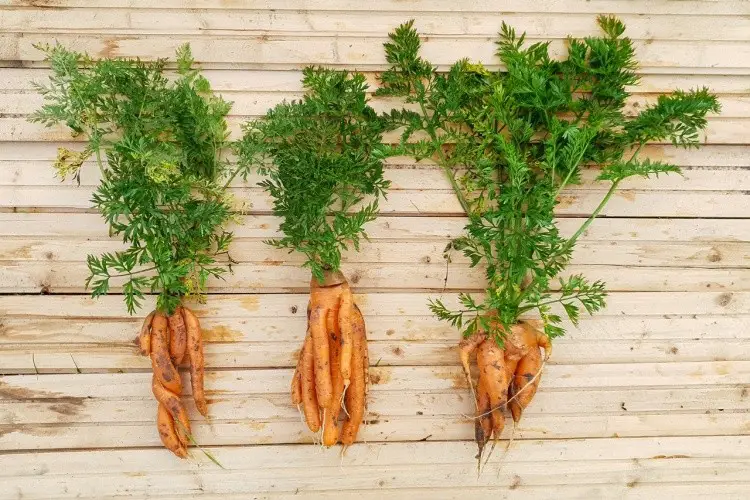Homegrown carrots are never as shapely as those from the supermarket. They don’t have to be, we think. But why do they often grow badly deformed?
If you grow your own carrots, you’ll be in for some surprises when you harvest them. Strange root shapes sometimes appear: multi-legged, crooked or twisted. There’s no question that these creatures have charisma, but as a gardener you still want carrots that are as straight as possible, not least because they are easier to clean and process.
One of the most important factors in the cultivation of root vegetables is the soil – and this is precisely the cause of misshapen growth.
When carrots grow multiple roots, it’s often a result of various factors, primarily environmental conditions and, in some cases, the carrot variety you’re growing.
Contents
Here are some common reasons for carrots developing multiple roots:
- Soil Conditions: The most common reason for carrots to fork or develop multiple roots is typically related to soil conditions. Carrots prefer loose, well-drained, and stone-free soil. If the soil is compacted or contains obstacles like rocks or hard clumps, the carrot roots may split and take on irregular shapes as they grow around these obstacles.
- Nutrient Imbalance: An imbalance in soil nutrients can also lead to irregular carrot growth. Excessive nitrogen in the soil can encourage the development of lush, leafy tops at the expense of root growth. This can result in malformed or multiple roots.
- Uneven Watering: Inconsistent or irregular watering can cause stress to carrot plants. As a response to this stress, carrots may produce multiple roots. To avoid this, maintain even moisture levels in the soil by providing regular and consistent watering.
- Carrot Variety: Some carrot varieties are more prone to forking or producing multiple roots than others. Choosing a variety known for straight, uniform roots can help mitigate this issue.
- Overcrowding: Planting carrots too closely together can lead to overcrowding and competition for space and nutrients, which can result in multiple root development.
- Thick or Compacted Soil: Carrots may develop multiple roots if they encounter hard or compacted layers of soil as they grow. This can cause the roots to split and form multiple branches.
To prevent or reduce the occurrence of multiple roots in your carrots, consider the following steps:
- Prepare the Soil: Prior to planting, ensure your soil is loose, well-drained, and free of obstacles like rocks and compacted soil layers. This will provide a conducive environment for straight carrot growth.
- Soil Testing: Conduct a soil test to assess nutrient levels and pH. Adjust the soil’s nutrient content to provide the ideal conditions for root development.
- Planting Depth: Plant carrot seeds at the appropriate depth (usually about 1/4 inch deep) to minimize the likelihood of roots encountering obstacles.
- Spacing: Plant carrot seeds with appropriate spacing to prevent overcrowding. Follow the recommended spacing for the specific carrot variety you’re growing.
- Watering: Keep the soil consistently moist but not waterlogged. Avoid letting the soil dry out completely between waterings.
- Weed Control: Ensure the carrot bed is free of weeds, which can compete with the carrots for nutrients and space.
By paying attention to these factors and selecting the right planting site, soil preparation, and variety, you can improve the chances of growing straight and uniform carrots without multiple roots.
Loose soil for beautiful carrots
The soil should be deeply loosened, sandy and humus-rich so that root vegetables such as carrots can develop fully in the soil. After all, if the subsoil is compacted or stony, the root tip sometimes dies and the buds next to it begin to sprout to grow around the obstacle. The result is “multi-legged” carrots.
Prevent soil-induced deformation by clearing the soil of stones and loosening it deeply with a digging fork before sowing. If necessary, work in sand.
Tip: On unsuitable soils, sowing on small embankments heaped with suitable soil has also proved successful.
The soil is loose and yet the carrots are strangely deformed? The cause of unwanted root branching can also be nematodes, which suck on the roots and lead to puny growth.
Why do my carrots burst open?
Larger cracks in root vegetables often occur as a result of heavy downpours: After prolonged dry periods, the beets quickly become saturated, causing them to burst open. Fertilization that is too rich in nitrogen also promotes the formation of cracks. Nevertheless, the carrots can be eaten and processed normally – the “blemish” is only visual.
Tip: A high humus content in the soil can help prevent cracking. Humus stores moisture, which means that the soil generally dries out less and the roots are supplied with more evenly.


